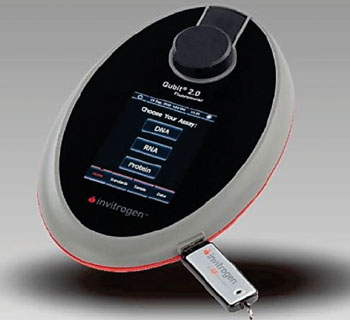New Method Simplifies Blood Biomarker Discovery and Analysis
By LabMedica International staff writers
Posted on 08 Sep 2016
A new gene expression analysis method has been developed to widen the usage of blood in biomarker discovery and analysis and the majority of the cells are erythrocytes that carry oxygen, causing 50% to 80% enrichment of globin ribonucleic acid (RNA) molecules among all blood RNA.Posted on 08 Sep 2016
As a type of liquid biopsy, blood is widely used in clinical studies due to its ease of sampling, its transport of biomolecules from all over the body and its rapid dynamics, but the high prevalence of globin complicates blood related gene expression biomarker studies, causing technical bias and leaving biologically relevant molecules undetectable.

Image: The Qubit 2.0 fluorometer analytical instrument for DNA, RNA, and protein quantitation (Photo courtesy of Thermo Fisher Scientific).
Scientists at the Karolinska Institute (Huddinge, Sweden) and their colleagues developed the new method that consists of a pair of short synthetic DNA strands that silence majority of globin RNA molecules by highly specific binding. The strands are introduced to purified RNA sample, and according to the team, being effective immediately after RNA denaturation and add only ten minutes of incubation time to the whole complementary DNA synthesis procedure.
The locking DNA molecules bind specifically at globin RNA poly-A site that is needed for further analysis. Therefore the globin RNAs are "locked" prior downstream manipulations and are unavailable to cause technical biases in blood RNA biomarker applications. RNA concentrations and the RNA integrity number (RIN) were measured with an Agilent 2100 Bioanalyzer Total RNA Nano kit (Agilent Technologies, Santa Clara, CA, USA) or Qubit Fluorometer (Thermo Fisher Scientific, Waltham, MA, USA).
Kaarel Krjutškov, PhD, the lead author of the study, said, “The globin reduction rate of GlobinLock (GL) is sufficient for any applications. It reduces the globin prevalence from 63% before to 5% which makes it an effective tool for biotechnology companies as an additive to their kits.” The authors concluded that they had developed a simple and cost-effective method to overcome globin mRNA caused limitation in biomarker studies when whole-blood RNA samples are used. The data presented obtained by qPCR and RNA-seq proofs the GL positive reduction effect with adult human whole-blood RNA samples and indicates its potential for species. The study was published on August 12, 2016, in the journal Scientific Reports.
Related Links:
Karolinska Institute
Agilent Technologies
Thermo Fisher Scientific













